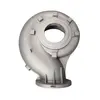Mobile:+86-311-808-126-83
Email:info@ydcastings.com
gearbox casing
Understanding Gearbox Casing Its Importance and Design Considerations
The gearbox casing, also known as the gear housing, serves a critical function in mechanical systems where rotational motion and torque are transferred. Found in a variety of applications, from automobiles and industrial machinery to aerospace and power generation, the casing plays a pivotal role in safeguarding the integrity of the gears and ensuring efficient operation.
Function and Importance of Gearbox Casing
The primary function of a gearbox casing is to encapsulate the gears, bearings, and other internal components, providing structural support and protection from external elements. The casing keeps contaminants like dirt, dust, and moisture at bay, which could otherwise lead to premature wear or failure of the gears. Additionally, it helps to contain the lubricants used in the gearbox, reducing the risk of leakage and ensuring that the gears operate smoothly.
Moreover, gearbox casings contribute to the overall efficiency of the system. A well-designed casing minimizes friction and heat generation, which are crucial factors in maintaining the longevity of the gear mechanism. By containing the lubricant and allowing it to circulate efficiently, the casing ensures that the gears remain adequately lubricated, reducing wear and tear.
Design Considerations for Gearbox Casings
When designing a gearbox casing, several factors must be taken into account to ensure optimal performance and durability.
1. Material Selection The choice of material is paramount in gearbox casing design. Common materials include aluminum, cast iron, and various alloys. Each material offers different benefits; for instance, aluminum is lightweight and resistant to corrosion, while cast iron provides excellent durability and vibration damping capabilities. The choice ultimately depends on the application requirements including weight, strength, and thermal properties.
gearbox casing

2. Load-Bearing Capacity The casing must be designed to withstand the loads exerted by the gears during operation. This involves considering factors such as torque, impact loads, and static loads, ensuring that the casing can support these forces without compromising structural integrity. Finite element analysis (FEA) is often utilized in the design phase to simulate stresses and optimize the casing's shape for load distribution.
3. Cooling and Lubrication Proper thermal management is crucial for gearbox longevity. The design should facilitate adequate cooling pathways, whether through natural convection or forced air cooling. Additionally, the casing must provide an efficient lubrication system that ensures even distribution of lubricant across all moving parts, preventing localized overheating and wear.
4. Ease of Maintenance A well-designed gearbox casing should also consider maintenance accessibility. Features such as removable access panels or inspection windows can facilitate easier maintenance operations, allowing for quick inspections, repairs, or lubricant changes without the need for complete disassembly.
5. Sealing Solutions To prevent the ingress of contaminants and leakage of lubricants, effective sealing solutions are necessary. The design should incorporate high-quality seals and gaskets, taking into account the operational environment, potential exposure to chemicals, and temperature variations.
6. Noise and Vibration Dampening Gearboxes inherently generate noise and vibrations during operation. The casing design can include features that help absorb or dampen these vibrations, contributing to quieter and smoother operation.
Conclusion
In summary, the gearbox casing is an integral component that significantly impacts the performance, durability, and efficiency of mechanical systems. Its design requires careful consideration of materials, load capacities, and maintenance accessibility. As technology advances, innovations in materials and design software allow for more sophisticated casings that enhance reliability and performance across various applications. By investing in optimal gearbox casing design, manufacturers can improve the longevity of their products and ensure a higher level of satisfaction for end users. The evolution of gearbox casing will likely continue to play a vital role in the ongoing advancement of mechanical engineering, driving further innovation in performance and efficiency.
-
Why Should You Invest in Superior Pump Castings for Your Equipment?NewsJun.09,2025
-
Unlock Performance Potential with Stainless Impellers and Aluminum End CapsNewsJun.09,2025
-
Revolutionize Your Machinery with Superior Cast Iron and Aluminum ComponentsNewsJun.09,2025
-
Revolutionize Fluid Dynamics with Premium Pump ComponentsNewsJun.09,2025
-
Optimizing Industrial Systems with Essential Valve ComponentsNewsJun.09,2025
-
Elevate Grid Efficiency with High-Precision Power CastingsNewsJun.09,2025











